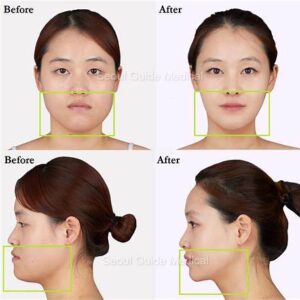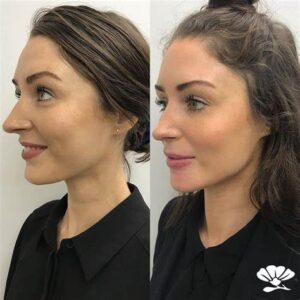Jawline Surgery Before and After: Recently Jawline surgery has emerged as the preferred feature for people looking for a more defined balanced, and youthful appearance. Popular for its striking “before and after” results the jawline procedure, often referred to as mandibular contouring (also known as jaw augmentation), alters the shape of the jaw in order to improve facial appearance and increase overall appearance and symmetry. The procedure’s transformation isn’t only about appearances, but usually brings functional advantages including improved aligning of the jaw and better oral health. In this post we’ll cover all you need to be aware of jawline surgery, its advantages, how it works risk, as well as what you can expect between “before” to “after.”
Understanding Jawline Surgery
Jawline surgery is the process of shaping or refining of the jawbone in order to give it an improved and more balanced appearance. This procedure is a bit different dependent on the requirements of the patient including reducing the width of the jaw and incorporating implants for increase in volume. This procedure is typically done by a maxillofacial specialist or a cosmetic surgeon having an expertise on facial anatomy.
Common Types of Jawline Surgery

Jawline Contouring, or Reduction The procedure is usually selected by people who feel that their jaws are too large or broad. This involves slicing off the jawbone in order to make an elongated, less delicate jawline.
Jawline Enhancement For people who want an enlarge, more noticeable jawline, fillers and implants are a possibility to achieve the ideal contour. Augmentation is usually preferred by those who want to get a smooth and masculine appearance.
Orthognathic Procedure The jawline surgery is recommended for patients who have functional issues that cause misalignment of the bites, for example. This kind of procedure aligns the jaw bones, and rectifies functional issues which can lead to cosmetic benefits and also aesthetic benefits.
Benefits of Jawline Surgery
A “before and after” transformation after jawline surgery usually leads to dramatic improvements in appearance and self-confidence. These are the main advantages:
Enhanced Face Symmetry An even jawline makes the face appear more balanced which is a crucial aspect in the aesthetics of facial features.
Enhanced profile Jawline surgery is a procedure that can dramatically boost the appearance of the face from side to side and make the facial appearance more distinct and more refined from every angle.
Higher confidence in oneself A lot of patients experience an boost in self-esteem after the procedure as they feel more at ease with their look.
Functional Benefits If you are undergoing orthodontia jawline surgery may rise the alignment of your bite and ease problems such as TMJ disorders, which could create chronic jaw pain.
Jawline Surgery Before and After: What to Expect|

If you’re thinking about jawline surgery, knowing the entire process from initial consultation through recovery will help you prepare for the changes that lie to come. This is a step-by-step procedure:
Consultation and Planning
During your appointment in the appointment, you’ll talk about your goals for aesthetics and issues with function with your surgeon. They will examine the facial structure and together digital images and 3D printing, they will create the virtual “before and after” model for you to get an idea of what you can expect in outcome.
Imagery and planning: Your surgeon can utilize X-rays and CT scans in order to make an exact sketch of your jaw’s anatomy. It helps in planning the placement of their the incisions, and then sculpt with precision.
Set realistic expectations These “before and after” images will be reviewed in depth and help to set realistic expectations, and making sure that your process is in line with your objectives.
The Surgery
Jawline surgery is usually done under general anesthesia. It could take between 2 and 4 hours compatible to the volume of the work involved. The type of surgery determine the specific procedures:
Jaw Reduction Surgery The surgeon creates cut-outs in the mouth or beneath the chin that allow for access to jawbone. The use of special tools is to create a contour for the bone trimming out prominent areas to give more supple appearance.
Jaw Augmentation Surgery Implants or bone grafts are placed strategically in order to rise the definition of the jawline. Implants typically consist of either porous or silicone, fixed using screws or plates, to warrant the stability.
Orthognathic Operation The more complicated procedure involves realigning both the jaws’ upper and lower jaws in order to rectify misalignment. Cuts in the bone are created then the jaw is then moved to the new location with the aid of plates and screws.
Recovery Process: From Swelling to Stunning Results
Recovery is crucial to getting the excellent “before and after” payoff. This is what you can expect from the recovery process:

Immediate Post-Surgery
Swelling and bruises There is a common tendency to suffer from significant bruising and swelling during the first few days after the operation. Cool compresses may help ease the symptoms.
Treatment for Pain Treatment for pain: Pain medication and antibiotics are often used to reduce pain and avoid infection.
diet adjustments The use of soft or liquid food is usually recommended during the initial few days in order so as to not strain the jaw.
Long-Term Recovery
Slowly Swelling Reduction Swelling usually subsides in the first 2 weeks. It could require several months for the left-over swelling to diminish.
Physical activity and Exercise Exercise and physical activity can be resumed in 2 weeks. Heavy lifting or strenuous exercise must be avoided for at most 4 to 6 weeks.
End Results The actual “before and after” transformation is visible in a matter of 3 to 6 months after swelling disappears completely and the jawline is able to settle into its new form.
Potential Risks and Complications
Just like any other surgical procedure jawline surgery comes with certain risks. Knowing these risks can assist you in making an educated choice.
Infection A possibility of getting an infection, especially where incisions are made within the mouth, where there are bacteria. The following post-operative guidelines will aid in reducing the possibility.
Nerve Injury Patients may feel numbness or tingling in the jaw or chin because of the proximity of nerves. The symptoms are usually short-term, however they could be permanent.
Implant shift (in Enhancement): Although rare implants are prone to shift from their place of placement. It could require extra surgical intervention to correct the problem.
Scarring Incisions that are made by mouth may create small scars. However they usually fade with the course of time.
Not a great result The final result may not be as per requirements, which may necessitate revision operation.
Comparing Jawline Surgery to Non-Surgical Alternatives
Jawline surgery is well-known for its stunning “before and after” results Certain non-surgical solutions are also able to improve the jawline, but at a lower level.
Dermal Fillers
Dermal fillers are a great way to give the jawline more volume and give the appearance of a larger jaw, without surgical intervention. Fillers, however, are only temporary and usually last between 6 and 12 months.
Botulinum Toxin Injections
Botulinum toxin injections, also known as Botox may reduce an overly large jawline through relaxing the muscles of the masseter. This opportunity is well-liked by those seeking an easier method for jaw reduction.
Thread Lifting
Thread lifting is the process of using temporary sutures to lift the jawline. This creates the appearance of a slight lift as well as definition. The outcome aren’t as dramatic as the jawline and will last around 1 year.
Jawline Surgery Before and After: Real Patient Stories
The sight of “before and after” photos as well as hearing stories from real patients are a great source of inspiration for people contemplating jawline surgery. Patients have reported that their surgery was transformative, giving them a sense of confidence as well as a new perspective regarding the world. A few patients encounter difficulties in healing however the end outcome are often worth it.
Is Jawline Surgery Right for You?
The jawline procedure is an option for achieving a clear and balanced jawline. But it’s not a appropriate option for all. People should take into consideration their health overall, their desires for aesthetics, and the desire to undergo surgery as well as recuperation.
Aesthetic Objectives Are you searching for an extensive, lasting alteration in your jawline? Surgery offers lasting payoff but it takes a greater level of commitment than alternatives that aren’t surgical.
Health Conditions The applicants must be in good physical health because certain health conditions could rise the likelihood of problems.
Budget Jawline surgery usually more expensive as compared to non-surgical alternatives, and this could affect the choice for certain.
Conclusion
Jawline procedure “before and after” transformations are truly transformative and offer patients the opportunity to obtain your ideal appearance and symmetry. Thanks to advances in techniques for surgery and individualized scheduling, this procedure has become safer and effective than it has ever been. It is important to evaluate the possible dangers, time to recover and the associated costs in order in order to make an educated choice. If you speak with an experienced doctor, you’ll be able to determine whether jawline surgery is appropriate for the aesthetic as well as functional requirements of your and will set you on the direction to fulfil a confident and refined appearance.





